Schwab's 7 investing principles
The fundamentals you need for investing success.
1. Establish a financial plan based on your goals.
Successful planning can help propel net worth.
Committing to a plan can put you on the path to building wealth. Investors who make the effort to plan for the future are more likely to take the steps necessary to achieve their financial goals.
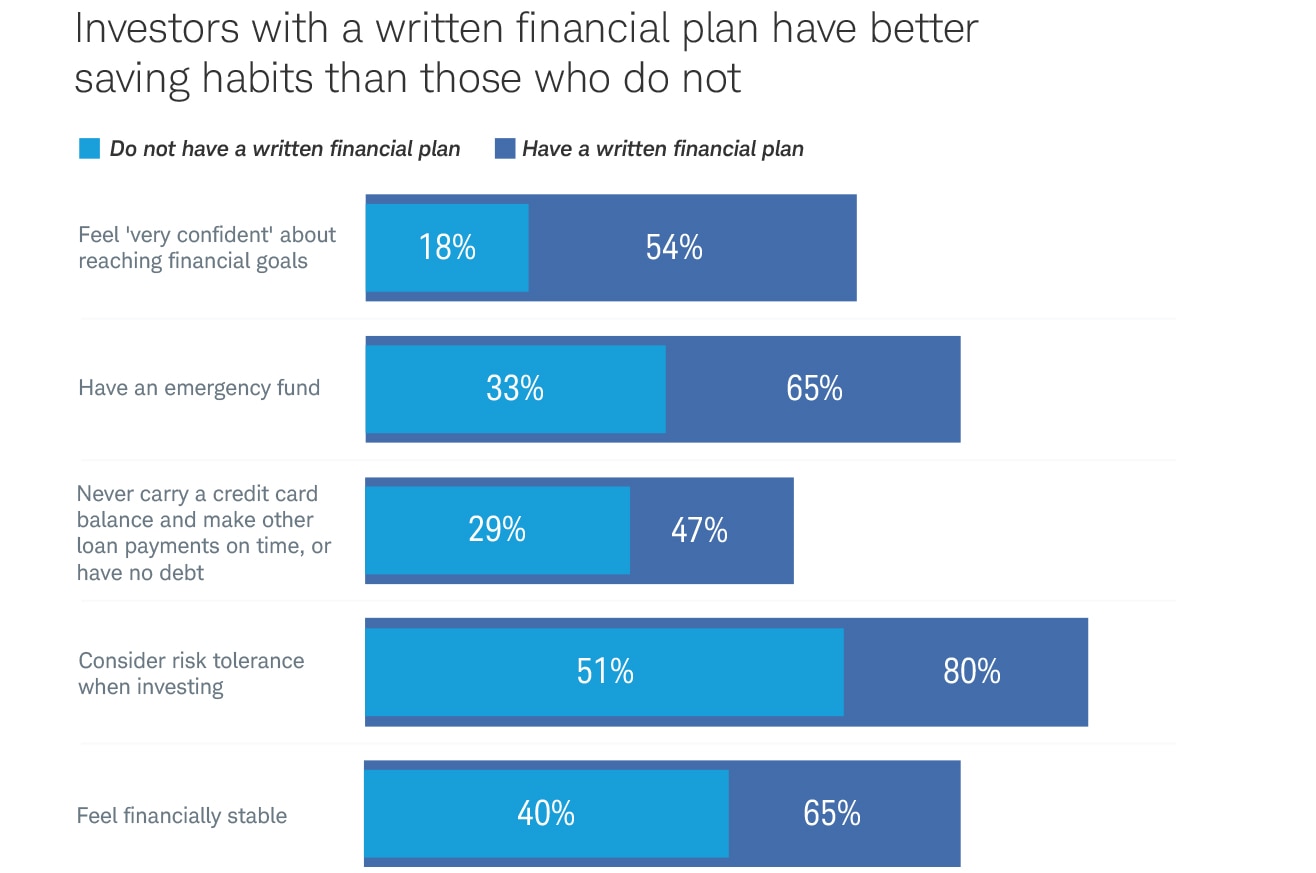
-
Source: Schwab Modern Wealth Survey. The online survey was conducted February 1–16, 2021, in partnership with Logica Research among a national sample of Americans aged 21 to 75.
Investing involves risk, including loss of principal. The information provided here is for general informational purposes only and should not be considered an individualized recommendation or personalized investment advice. The investment strategies mentioned here may not be suitable for everyone. Each investor needs to review an investment strategy for his or her own particular situation before making any investment decision.
Data contained herein from third party providers is obtained from what are considered reliable sources. However, its accuracy, completeness or reliability cannot be guaranteed. Supporting documentation for any claims or statistical information is available upon request.
The Schwab Center for Financial Research is a division of Charles Schwab & Co., Inc.
2. Start saving and investing today.
It pays to invest early.
Maria and Ana each invested $3,000 every year on January 1 for 10 years—regardless of whether the market was up or down. But Maria started 20 years ago, whereas Ana started only 10 years ago. So although they each invested a total of $30,000, by 2021 Maria had about $93,000 more because she was in the market longer.
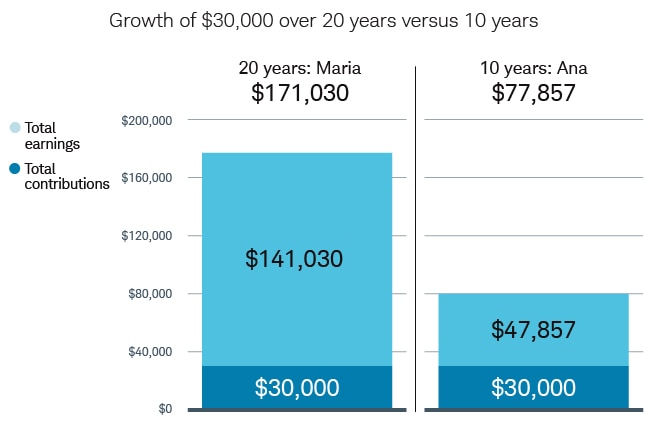
-
Source: Schwab Center for Financial Research with data from Morningstar. Invested in a hypothetical portfolio that tracks the S&P 500® Index from January 1, 2002–December 31, 2021 for Maria, and from January 1, 2012–December 31, 2021 for Ana. The end amount includes capital appreciation and dividends. Dividends are assumed to be reinvested when received. Fees and expenses would lower returns. Ana's average annual rate of return is 16.6%; Maria's is 9.5%. The actual rate of return will fluctuate with market conditions. Past performance is no indication of future results.
Indexes are unmanaged, do not incur management fees, costs and expenses, and cannot be invested in directly.
Don't try to predict market highs and lows.
The market is volatile by nature, and many investors are tempted to get out of the market when things turn bad. But that doesn’t necessarily work out in your favor. For example, if you had invested $100,000 on January 1, 2021, but missed the top 10 trading days, you would have had $20,858 less by the end of the year than if you’d stayed invested the whole time.
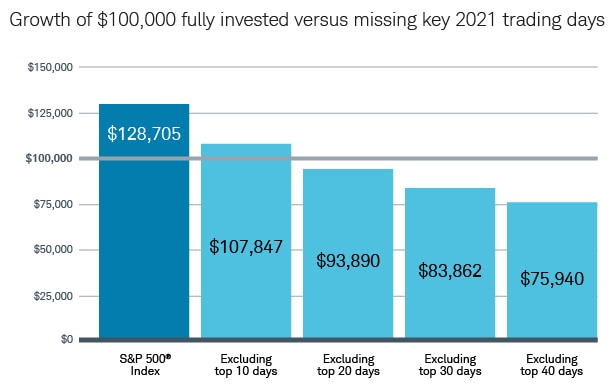
-
Source: Schwab Center for Financial Research with data from Morningstar. The year begins on the first trading day in January and ends on the last trading day of December, and daily total returns were used. Returns assume reinvestment of dividends. Fees and expenses would lower returns. When out of the market, cash is not invested. Market returns are represented by the S&P 500 Index, an index of widely traded stocks. Top days are defined as the best performing days of the S&P 500 during 2021. This chart represents a hypothetical investment and is for illustrative purposes only. Past performance is no indication of future results.
3. Build a diversified portfolio based on your tolerance for risk.
Asset classes perform differently.
$100,000 invested at the beginning of 2002 would have had a volatile journey to nearly $620,000 by the end of 2021 if invested in U.S. stocks. If invested in cash investments or bonds, the ending amount would be lower, but the path would have been smoother. Investing in a moderate allocation portfolio would have captured some of the growth of stocks with lower volatility over the long term.
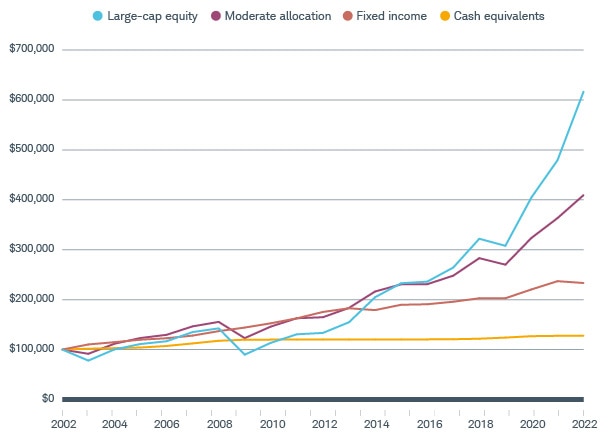
-
Source: Schwab Center for Financial Research with data from Morningstar. The indexes used are: S&P 500® (large cap equity), Russell 2000® (small cap equity), MSCI EAFE® Net of Taxes (international equity), Bloomberg U.S. Aggregate Bond Index (fixed income), FTSE U.S. 3-Month Treasury Bill Index (cash equivalents). The Moderate Allocation is 35% large cap equity, 10% small cap equity, 15% international equity, 35% fixed income, and 5% cash, using the indexes noted. Past performance is no indication of future results. Indexes are unmanaged, do not incur management fees, costs and expenses, and cannot be invested in directly. This chart represents a hypothetical investment and is for illustrative purposes only.
It's been nearly impossible to predict which asset classes will perform best in a given year.
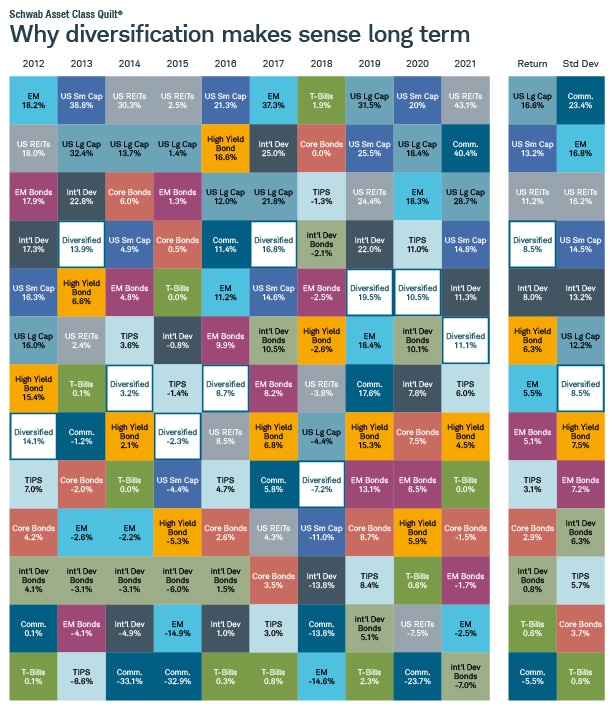
-
Source: Morningstar Direct and the Schwab Center for Financial Research. Data is from 2012–2021. Asset class performance represented by annual total returns for the following indexes: S&P 500® Index (U.S. Lg Cap), Russell 2000® Index (U.S. Sm Cap), MSCI EAFE® net of taxes (Int'l Dev), MSCI Emerging Markets IndexSM (EM), S&P United States REIT Index and S&P Global Ex-U.S. REIT Index (REITs), S&P GSCI® (Commodities), Bloomberg U.S. Treasury Inflation-Protection Securities (TIPS) Index, Bloomberg U.S. Aggregate Bond Index (Core Bonds), Bloomberg U.S. High-Yield Very Liquid Index (High Yld Bonds), Bloomberg Global Aggregate Ex-USD TR Index (Int'l Dev Bonds), Bloomberg Emerging Markets USD Bond TR Index (EM Bonds), FTSE U.S. 3-Month Treasury Bill Index.
The diversified portfolio is a hypothetical portfolio consisting of 18% S&P 500, 10% Russell 2000, 3% S&P U.S. REIT, 12% MSCI EAFE, 8%, MSCI EAFE Small Cap, 8% MSCI EM, 2% S&P Global Ex-U.S. REIT, 1% Bloomberg U.S. Treasury 3-7 Year Index, 1% Bloomberg Agency, 6% Bloomberg Securitized, 2% Bloomberg U.S. Credit, 4% Bloomberg Global Agg Ex-USD, 9% Bloomberg VLI High Yield, 6% Bloomberg EM, 2% S&P GCSI Precious Metals, 1% S&P GSCI Energy, 1% S&P GSCI Industrial Metals, 1% S&P GSCI Agricultural, 5% Bloomberg Short Treasury 1-3 Month Index. Including fees and expenses in the diversified portfolio would lower returns. The portfolio is rebalanced annually. Returns include reinvestment of dividends, interest, and capital gains. Indexes are unmanaged, do not incur fees or expenses, and cannot be invested in directly. Past performance is no indication of future results. Diversification strategies do not ensure a profit and do not protect against losses in declining markets.
Important info about asset allocation
-
For illustrative purposes only. Not representative of any specific investment or account.
Annualized returns are calculated using data from 1992 through 2021 and include reinvestment of dividends, interest, and capital gains. Stocks are represented by the S&P 500 Index, bonds by Bloomberg U.S. Aggregate Bond Index and cash by the Ibbotson US 30 Day Treasury Bill Index. Indexes are unmanaged, do not incur fees or expenses, and cannot be invested directly. Past performance is not a guarantee of future results.
The information provided here is for general informational purposes only and should not be considered an individualized recommendation or personalized investment advice.
4. Minimize fees and taxes.
Fees can eat away at your returns.
$3,000 is invested in a hypothetical portfolio that tracks the S&P 500 Index every year for 10 years, then nothing is invested for the next 10 years. Over 20 years, lowering fees by three-quarters of a percentage point would save Maria roughly $17,000 and Ana roughly $3,500.
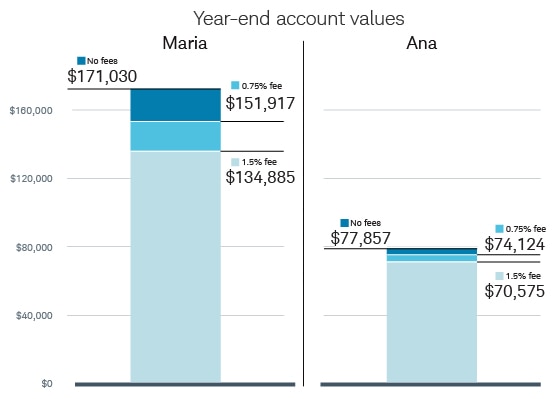
-
Source: Schwab Center for Financial Research with data from Morningstar. The hypothetical investor invests $3,000 on the first day of January of every year for 10 years. Returns are assessed a fee at year-end. The hypothetical portfolio tracks the S&P 500 Index from January 1, 2002, to December 31, 2021, with $3,000 in annual contributions invested for just the first 10 years. In scenarios involving fees, those fees are paid annually each year. Chart does not take into account the effects of any possible taxes.
Indexes are unmanaged, do not incur management fees, costs and expenses, and cannot be invested in directly.
Try to minimize taxes.
$3,000 is invested in a hypothetical portfolio that tracks the S&P 500 Index every year for 10 years, then nothing is invested for the next 10 years. Asset location matters. Placing investments in a tax-deferred account can result in higher ending wealth after 20 years.

-
Source: Schwab Center for Financial Research with data from Morningstar. In the tax-deferred hypothetical scenario, $3,000 is invested in a hypothetical
portfolio that tracks the S&P 500 Index every year for 10 years, then nothing is invested for the next 10 years. The account earns capital appreciation and dividends. Dividends are assumed to be reinvested when received. Maria makes a lump-sum withdrawal in year 20, when she is in the 24% marginal tax bracket. In the taxable scenario, Maria is in the 24% marginal tax bracket and after taxes invests $2,250 in a hypothetical portfolio that tracks the S&P 500 Index every year for 10 years. She invests nothing for the next 10 years, leaving her money fully invested. The account earns dividends, which are taxed at 15%, and recognizes capital gains every 5 years, which are taxed at 15% with net proceeds reinvested. Performance is based on historical returns of the S&P 500 from January 1, 2002–December 31, 2021. This information does not constitute and is not intended to be a substitute for specific individualized tax, legal, or investment planning advice. Where specific advice is necessary or appropriate, Schwab recommends consultation with a qualified tax advisor, CPA, financial planner, or investment manager.
5. Build in protection against significant losses.
Steep declines are hard to bounce back from.
In recent downturns, an all-stock portfolio took longer than a diversified portfolio to return to its prior peak.
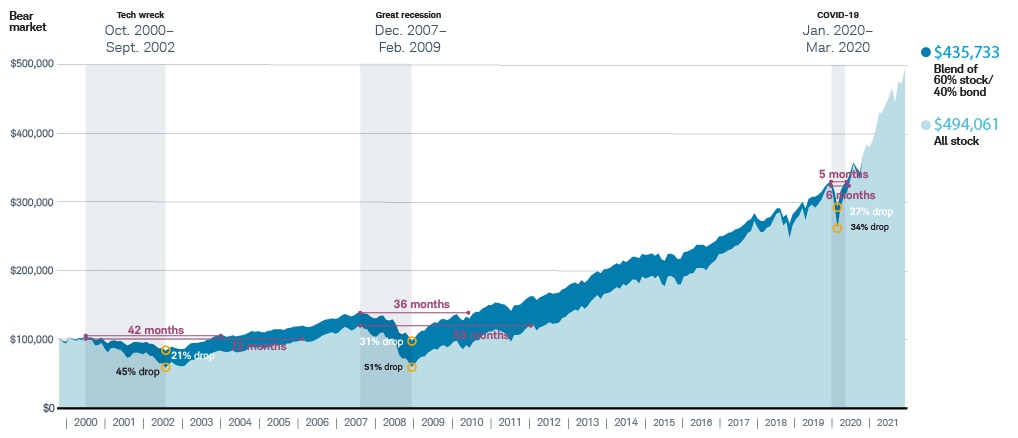
-
Source: Schwab Center for Financial Research with data from Morningstar. Stocks are represented by total annual returns of the S&P 500® Index, and bonds are represented by total annual returns of the Bloomberg U.S. Aggregate Bond Index. The 60/40 portfolio is a hypothetical portfolio consisting of 60% S&P 500 Index stocks and 40% Bloomberg U.S. Aggregate Bond Index bonds. The portfolio is rebalanced annually. Returns include reinvestment of dividends, interest, and capital gains. Fees and expenses would lower returns. Diversification does not eliminate the risk of investment losses. Past performance is no indication of future results.
Defensive asset classes have performed better when stocks break down.
During two recent market downturns, defensive assets had positive returns—significantly outperforming U.S. stocks.
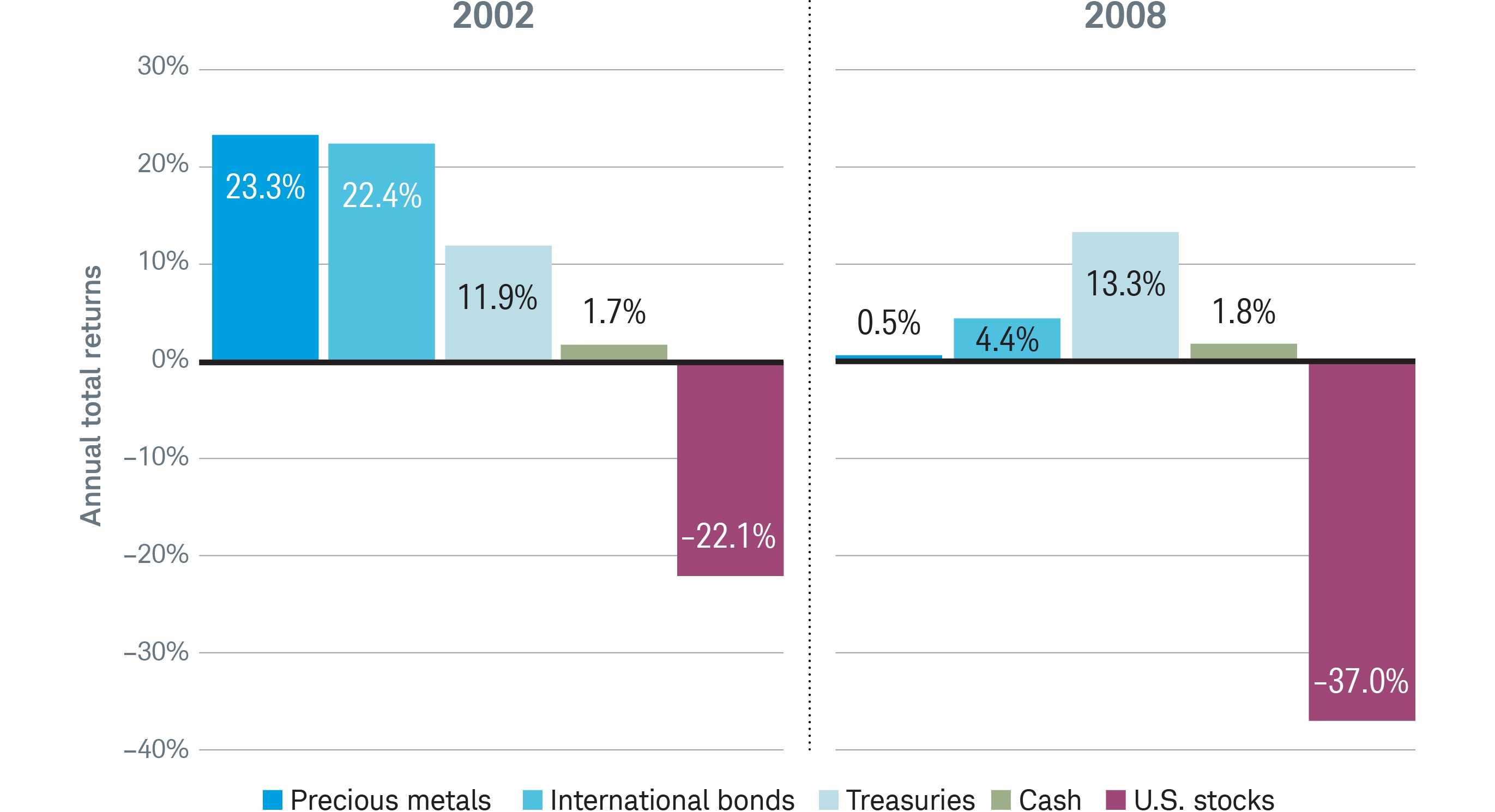
-
Source: Schwab Center for Financial Research with data provided by Morningstar. The two periods were selected to show how defensive asset classes performed when US stocks decrease by more than 20% annually in the 20-year time period from 2002 to 2021. Indexes representing each asset class are S&P 500 TR Index (US stocks), FTSE U.S. 3-Month Treasury Bill Index, Bloomberg US Treasury 3-7 Year TR Index (treasuries), S&P GSCI Precious Metal TR Index (precious metals), Bloomberg Global Aggregate Ex-US Bond TR Index (international bonds). Returns assume reinvestment of dividends and interest. Fees and expenses would lower returns. International investing may involve greater risk than U.S. investments due to currency fluctuations, unforeseen political and economic events, and legal and regulatory structures in foreign countries. Such circumstances can potentially result in a loss of principal. Past performance is no indication of future results. Indexes are unmanaged, do not incur fees and expenses, and cannot be invested in directly. This chart is for illustrative purposes only.
6. Rebalance your portfolio regularly.
Regular rebalancing helps keep your portfolio aligned with your risk tolerance.
A portfolio began with a 50/50 allocation to stocks and bonds and was never rebalanced. Over the next 12 years, the portfolio drifted to an allocation that was 78% stocks and only 22% bonds—leaving it positioned for larger losses when the market turned in 2022 than it would have experienced if it had been rebalanced regularly.
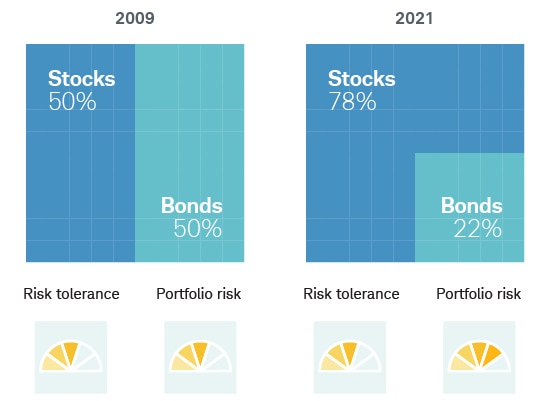
-
Source: Schwab Center for Financial Research with data from Morningstar. The hypothetical portfolio above is composed of 50% stocks and 50% bonds on 12/31/2009 and is not rebalanced through12/31/2021. Asset class allocations are derived from a weighted average of the total monthly returns of indexes representing each asset class. The indexes representing the asset classes are the S&P 500 Index (stocks) and the Bloomberg U.S. Aggregate Bond Index (bonds). Returns assume reinvestment of dividends and interest. Indexes are unmanaged, do not incur fees and expenses, and cannot be invested in directly. Rebalancing may cause investors to incur transaction costs and, when rebalancing a non-retirement account, taxable events may be created that may increase your tax liability. Rebalancing a portfolio cannot ensure a profit or protect against a loss in any given market environment.
7. Ignore the noise.
Progress toward your goal is more important than short-term performance.
Over 20 years, markets went up and down—but a long-term investor who stuck to her plan would have been rewarded.
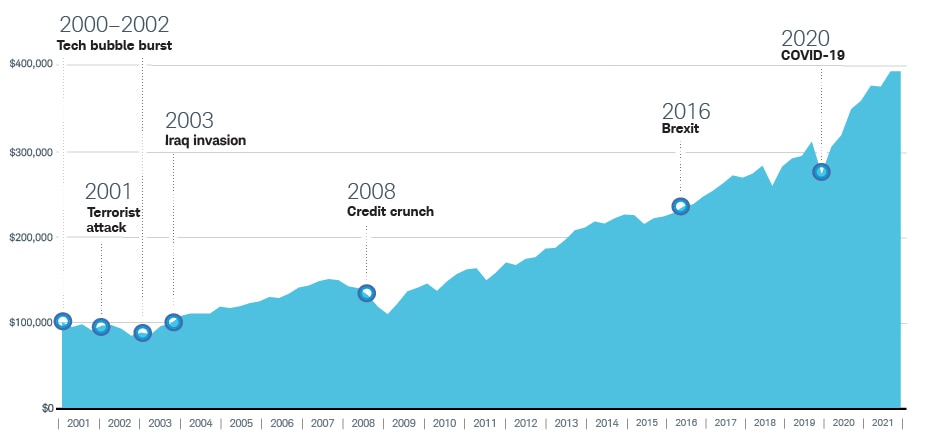
-
Source: Schwab Center for Financial Research with data from Morningstar. The chart illustrates the growth of $100,000 invested in a hypothetical moderate allocation from 12/1/2000 to 12/1/2021 The asset allocation plan is weighted averages of the performance of the indexes used to represent each asset class in the plans and are rebalanced annually. Returns include reinvestment of dividends and interest. The indexes representing each asset class are S&P 500 Index (large-cap stocks), Russell 2000 Index (small-cap stocks), MSCI EAFE Net of Taxes (international stocks), Bloomberg U.S. Aggregate Index (bonds), and FTSE U.S. 3-Month Treasury Bill Index (cash investments). The Moderate allocation is 35% large-cap stocks, 10% small-cap stocks, 15% international stocks, 35% bonds, and 5% cash investments. Past performance is no indication of future results. Indexes are unmanaged, do not incur fees and expenses, and cannot be invested in directly. This chart represents a hypothetical investment and is for illustrative purposes only.
Questions? We're ready to help.
It's been nearly impossible to predict which asset classes will perform best in a given year.
RPS Chart 9
*Options carry a high level of risk and are not suitable for all investors. Certain requirements must be met to trade options through Schwab. Please read the Options Disclosure Document titled Characteristics and Risks of Standardized Options before considering any option transaction. Investing involves risks, including loss of principal. Hedging and protective strategies generally involve additional costs and do not ensure a profit or guarantee against loss.
The information provided here is for general informational purposes only and should not be considered an individualized recommendation or personalized investment advice. The investment strategies mentioned here may not be suitable for everyone. Each investor needs to review an investment strategy for his or her own particular situation before making any investment decision.
All expressions of opinion are subject to change without notice in reaction to shifting market conditions. Data contained herein from third-party providers is obtained from what are considered reliable sources. However, its accuracy, completeness or reliability cannot be guaranteed.
Examples provided are for illustrative purposes only and not intended to be reflective of results you can expect to achieve.
This information is not intended to be a substitute for specific individualized tax, legal or investment planning advice. Where specific advice is necessary or appropriate, please consult with a qualified tax advisor, CPA, financial planner or investment manager.
Fixed income securities are subject to increased loss of principal during periods of rising interest rates. Fixed-income investments are subject to various other risks, including changes in credit quality, market valuations, liquidity, prepayments, early redemption, corporate events, tax ramifications and other factors. High-yield bonds and lower-rated securities are subject to greater credit risk, default risk, and liquidity risk.
Investing involves risk including loss of principal.
Municipals and tax-exempt bonds are not necessarily a suitable investment for all persons. Information related to a security's tax-exempt status (federal and in-state) is obtained from third parties, and Schwab does not guarantee its accuracy. Tax-exempt income may be subject to the alternative minimum tax (AMT). Capital appreciation from bond funds and discounted bonds may be subject to state or local taxes. Capital gains are not exempt from federal income tax.
Diversification strategies do not ensure a profit and do not protect against losses in declining markets.
International investments involve additional risks, which include differences in financial accounting standards, currency fluctuations, geopolitical risk, foreign taxes and regulations, and the potential for illiquid markets. Investing in emerging markets may accentuate these risks.
Treasury Inflation Protected Securities (TIPS) are inflation-linked securities issued by the U.S. government whose principal value is adjusted periodically in accordance with the rise and fall in the inflation rate. Thus, the interest amount payable is also impacted by variations in the inflation rate as it is based upon the principal value of the bond. It may fluctuate up or down. Repayment at maturity is guaranteed by the U.S. government and may be adjusted for inflation to become the greater of either the original face amount at issuance or that face amount plus an adjustment for inflation.
Real Estate Investment Trusts (REITs): Risks of REITs are similar to those associated with direct ownership of real estate, such as changes in real estate values and property taxes, interest rates, cash flow of underlying real estate assets, supply and demand, and the management skill and credit worthiness of the issuer.
Commodity-related products may be extremely volatile and illiquid and can be significantly affected by underlying commodity prices, world events, import controls, worldwide competition, government regulations, and economic conditions, regardless of the length of time shares are held. Investments in commodity-related products may subject the fund to significantly greater volatility than investments in traditional securities and involve substantial risks, including risk of loss of a significant portion of their principal value.
Indexes are unmanaged; do not incur management fees, cost, or expenses; and cannot be invested in directly.
Small-cap stocks are subject to greater volatility than those in other asset categories.
Indexes are unmanaged, do not incur management fees, costs and expenses, and cannot be invested in directly. For more information on indexes, please see Schwab.com/IndexDefinitions.
"Schwab" refers to Charles Schwab & Co., Inc.
Insights & Education are provided by Charles Schwab & Co., Inc.